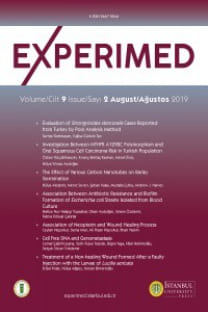Diyabetik ve Diyabetik Olmayan Kronik Böbrek Yetmezliğinde Dinamik Tiyol Disülfit Homeostazı ve İleri Protein Oksidasyon Ürünleri (AOPPs)
Tiyol-disülfit homeostazı, ileri oksidasyon protein ürünleri, oksidatif stres, kronik böbrek yetmezliği
Dynamic Thiol Disulphide Homeostasis and Advanced Oxidation Protein Products (AOPPs) in Diabetic And Non-Diabetic Chronic Renal Failure Disease
Thiol disulphide homeostasis advanced oxidation protein products, oxidative stress, chronic renal failure, type 2 diabetes,
___
- 1. Venus S, Teresa M, Rosa S, Rosanna P, Hiroshi K, Matilde EL. Oxidative stress and cancer: an overview. Ageing Res Rev 2013; 12: 376- 390. 2. Subash CG, David H, Sridevi P, Byoungduck P, Wonil K, Bharat BA. Upsides and downsides of reactive oxygen species for cancer: the roles of reactive oxygen species in tumorigenesis, prevention, and therapy. Antioxi Redox Signal 2011; 16: 1295-1322. 3. Jan G. Oxidative stress in chronic renal failure. Nephrol Dial Transplant 2001; 16: 2135- 2137. 4. Suziy MB, Lucas JSF, Glaucevane SG, Luíza AR, Marília OFG, Sandra MLV. Oxidative stress as an underlying contributor in the development of chronic complications in diabetes mellitus. Int J Mol 2013; 14: 3265-3284. 5. Tohru F, Masuko UF. Superoxide dismutases: role in redox signaling, vascular function, and diseases. Antioxi Redox Signal 2011; 15: 1583-1606. 6. Aksenova MV, Aksenov MY, Payne RM, Trojanowski JQ, Schmidt ML, Carney JM, · Butterfield DA, Markesbery WR. Oxidation of cytosolic proteins and expression of creatine kinase BB in frontal lobe in different neurodegenerative disorders. Dement Geriatr Cogn Disord 1999;10: 158–165. 7. Dobashi K, Ghosh B, Orak JK, Singh I, Singh AK. Kidney ischemia-reperfusion: modulation of antioxidant defences. Mol Cell Biochem 2000; 205: 1-11. 8. Gottlieb RA, Mentzer RM. Autophagy during cardiac stress: joys and frustrations of autophagy. Annu Rev Physiol 2010; 72: 45–59. 9. Marian V, Dieter L, Jan M, Mark TD, Milan M, Joshua T. Free radicals and antioxidants in normal physiological functions and human disease. Int J Biochem Cell B Journal 2007; 39: 44-84. 10. Esra B, Umit MS, Cansin S, Serpil E, Omer K. Oxidative stress and antioxidant defense. WAO Journal 2012; 5: 9–19. 11. Witko-Sarsat V, Friedlander M, Capeillere- Blandin C et al. Advanced oxidation protein products as a novel marker of oxidative stress in uremia. Kidney Int 1996; 49: 1304– 1313. 12. Ozcan E, Salim N. A novel and automated assay for thiol/disulphide homeostasis. Clin Biochem 2014; 47: 326-332. 13. Turell L, Radi R, Alvarez B. The thiol pool in human plasma: the central contribution of albumin to redox processes. Free Radic Biol Med 2013; 65: 244–253. 14. Gumusyayla S, Vural G, Bektas H, Deniz O, Neselioglu S, Erel O. A novel oxidative stress marker in patients with Alzheimer’s disease: dynamic thiol–disulphide homeostasis. Acta Neuropsychiatr 2016; 4: 1-6. 15. Katarina S, Kristina K, Juliana F, Juraj H, L’udmila P, August H. Advanced oxidation protein products and advanced glycation end products in children and adolescents with chronic renal insufficiency. J Renal Nutr 2012; 22: 143-148. 16. Wei C, Fan FH, Jing N. AOPPs and the progression of kidney disease. Kidney Int Suppl 2014; 4: 102–106. 17. Agnieszka P, Maria KK, Maria W. AOPP and its relations with selected markers of oxidative/ antioxidative system in type 2 diabetes mellitus. Diabetes Res Clin Pract 2007; 77: 188–192. 18. George E, Hiro L. A precise method for the determination of whole blood and plasma sulfhydryl groups. Anal Biochem 1979; 93: 98-102. 19. Jonathan H, Ellen M, Elizabeth M. Plasma protein thiol oxidation and carbonyl formation in chronic renal failure. Kidney Int 2000; 58: 2571–2578. 20. Fowler MJ. Microvascular and macrovascular complications of diabetes. Clin Diabetes 2008; 26: 77–82. 21. Antonio C, Roberto T. Antioxidant anti-inflammatory treatment in type 2 diabetes. Diabetes Care 2009; 32: 232-236. 22. Jeevan KS, Mungli P, Sudeshna T, Manish V, Nagaraj KS, Pampapathy S. Serum paraoxonase activity and protein thiols in chronic renal failure patients. Asian J Biochem 2007; 2: 274-278. 23. Matteucci E, Giampietro O. Thiol signalling network with an eye to diabetes. Molecules 2010;15: 8890–8903. 24. Mezzano D, Pais EO, Aranda E, Olga P, Patricio D, Mireya O, Rodrigo T, Fernando G, Teresa Q, Soledad C, Federico L, Jaime P. Inflammation, not hyperhomocysteinemia, is related to oxidative stress and hemostatic and endothelial dysfunction in uremia. Kidney Int 2001; 60: 1844–1850. 25. Baskol G, Gumus K, Oner A, Arda H, Karakucuk S. The role of advanced oxidation protein products and total thiols in diabetic retinopathy. Eur J Ophthalmol 2008; 18: 792-798. 26. Kalousová M, Skrha J, Zima T. Advanced glycation end-products and advanced oxidation protein products in patients with diabetes mellitus. Physiol Res 2002; 51: 597-604. 27. Uzun H, Konukoğlu D, Gelişgen R, Zengin K, Taşkın M. Plasma protein carbonyl and thiol stress before and after laparoscopic gastric banding in morbidly obese patients. Obes Surg 2007; 17: 1367-1373. 28. Oberg BP, Mcmenamin E, Lucas FL, Mcmonagle E, Morrow J, Ikizler TA, Himmelfarb J. Increased prevalence of oxidant stress and inflammation in patients with moderate to severe chronic kidney disease. Kidney Int 2004; 65: 1009–1016. 29. Witko-Sarsat V, Friedlander M, Khoa TN, Blandin C, Nguyen AT, Canteloup S, Dayer JM, Jungers P, Tilman D, Beatrice DL. Advanced oxidation protein products as novel mediators of inflammation and monocyte activation in chronic renal failure. J Immunol 1998; 161: 2524–2532.
- Yayın Aralığı: Yılda 3 Sayı
- Başlangıç: 2011
- Yayıncı: İstanbul Üniversitesi
Antibiyotiklerin Akılcı Kullanımının Ebeveynler Üzerinde Araştırılması
Elif Sinem BİRELLER, Ayşe Büşra DİNÇ, Elif ŞAHİN, Arzu ERGEN, Bedia ÇAKMAKOĞLU
Neslihan Çoban, Dilek Pirim, Aycan Fahri Erkan, Filiz Güçlü-Geyik, Berkay Ekici, Nihan Erginel-Ünaltuna
Cihan COŞKUN, Hümeyra ÖZTÜRK EMRE, Alper GÜMÜŞ, Sami Uzun, Serhat KARADAĞ, Ahmet BEHLÜL, Muhammet Emin DÜZ, Macit KOLDAŞ, Savaş ÖZTÜRK
Gülay Özel Cavlak ÖZEL CAVLAK, Mehmet CAVLAK, Kubilay KINOĞLU, A.begüm CEVİZ, Allison P. ERONAT, Bülent ŞAM, Mustafa YILDIZ, Bülent BAYRAKTAR, Hülya Yılmaz AYDOĞAN, Oğuz ÖZTÜRK
Hülya YILMAZ AYDOĞAN, Serap İLİKAY, Zehra BUĞRA, Oğuz ÖZTÜRK
ALS Sinek Modelinde Nörodejenerasyon Mekanizmasının Proteomik ve Genetik Analizi
